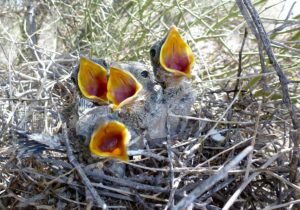By John Arnett, Edwin Juarez and Kurt Licence

The Sonoran Desert, an environment with blistering summer temperatures, frigid winter nights, and months of no precipitation, tests many of its residents to the thresholds of their physiological tolerances. Over 60 species of birds breed in this environment and many populations are naturally small and typically at low density. As a result, these species may be particularly vulnerable to progressively growing threats, including habitat loss and fragmentation due to altered landscapes, border-related activities, climate change, and invasive species. These issues, among others, have made a robust monitoring program necessary to assess the status and trends of these desert-dwelling species, inform conservation strategies for priority species, and help keep common species common.
Natural resource managers in the region are challenged to effectively monitor bird populations and develop and implement proactive management plans. Several factors contribute to the challenge: the vast amount of land area, often inaccessible because of few roads and rugged terrain, U.S.-Mexico border-related safety issues, and wide temporal asynchrony of breeding activity between various species. Through the Arizona Bird Conservation Initiative (ABCI, a partnership coordinated by the Arizona Game and Fish Department) various partners have joined to promote the development of a unified breeding bird monitoring strategy that will help us better understand the distribution, habitat use, and population status and trends of poorly-monitored bird species and species of concern of the Sonoran Desert.

The study area includes native Sonoran Desert habitats (Upper and Lower Sonoran), including dry washes in southern and western Arizona. This 3-year project began in 2012 and will run through the 2014 breeding season, with additional 3-year cycles to be repeated in the future to quantify long-term trends. We have established monitoring plots (16 or 24 hectares) across the desert and are using a double sampling methodology (with an area search approach) for surveying plots. In 2012 we surveyed 96 plots, followed by 91 additional plots in 2013. We have recorded over 130 species, with Black-throated Sparrow, Verdin, Black-tailed Gnatcatcher, Ash-throated Flycatcher, Mourning Dove, and House Finch being the most abundant.
An important component of this project is the high level of coordination across the landscape. ABCI brings together numerous partners including Department of Defense, Tohono O’odham Nation, Bureau of Land Management, Arizona Game and Fish Department, U.S. Fish and Wildlife Service (including Sonoran Joint Venture), Tonto National Forest, National Park Service, National Audubon Society and Tucson Audubon Society, and other collaborators across the region. This coordination facilitates pooling of resources to work at a much larger scale than would be possible otherwise. It also helps resource managers in the region to better understand their level of stewardship for Sonoran Desert birds.
To learn more about this effort, contact Edwin Juarez.


1 thought on “Sonoran Desert Breeding Bird Surveys: a coordinated approach”
Comments are closed.